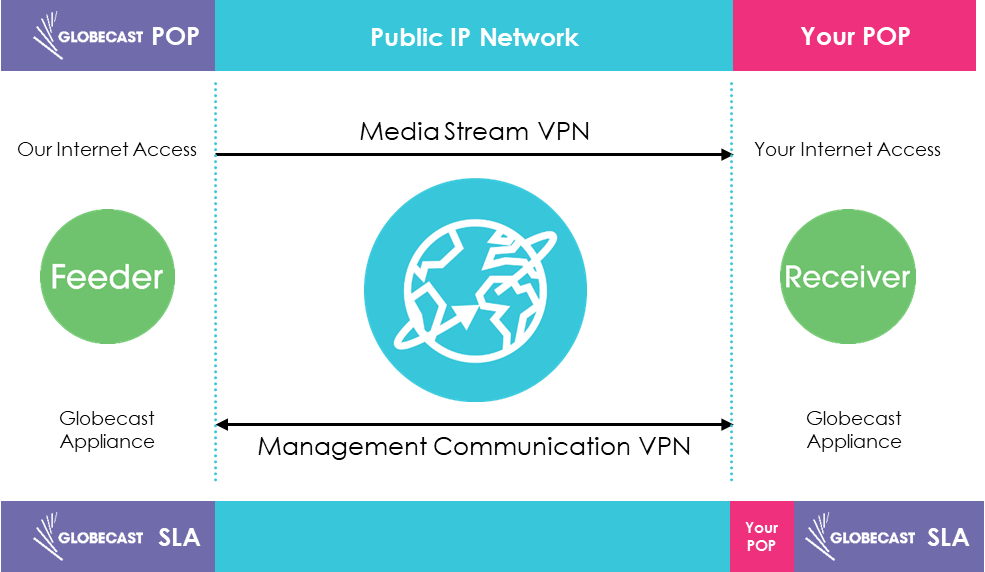It’s 2021, and there’s still a lot to talk about when it comes to video distribution over the public internet. Not that there are discussions about the possibilities — come on, it’s 2021— the world has been using public internet for video for the past 20 years. What we mean is, there are a lot of myths about what’s “not possible”, what will “never work” or what should “never be done”. Let’s review and debunk some of these myths about video distribution over the public internet.
-
You can’t use it for premium feed
Public internet is a tool to securely deliver a video stream to any internet connected point. ARQ protocols such as SRT, RIST and Zixi have been developed to provide broadcast-grade delivery. Access to the public internet is easier and can be more cost-effective than fibre or satellite. Euronews uses internet-based delivery to become “glocal” by adapting its channels to its multiple local audiences: “Our overarching goal with this project is to reach a more multicultural audience and deliver universally appealing content. (…) With it, we’re able to increase our channel count and reach a more diverse audience without increasing our costs,” said Francois Schmitt, Chief Operating Officer at Euronews.
-
Internet means late
ARQ protocols were built specifically for video distribution (TS IP, TS ASI and SDI), taking into account signal component integrity, security and low latency. For instance, from Paris to Los Angeles is only 260ms and from Paris to Singapore less than 500ms. Depending on the buffer settings to secure the level of congestion, the latency can be reduced.
-
QoS is bad on the Internet
When we talk about the internet it raises the question: what about QoS? Of course, we can’t guarantee any QoS over just over the internet, and because the route from A to B is unpredictable, it requires a lot of security, too. Besides, as a leading supplier in video content delivery worldwide for more than 20 years now, we maintain our solution-agnostic position. It helps us keep an accurate and unbiased eye on the market so that we can find the most reliable solutions for our customers. The internet is a formidable tool to reach a destination in an efficient way, but we have to use some hardware and software solutions in order to provide quality and monitoring at the same level as we provide using satellite, for instance. That’s why we choose to base our internet offer on a physical “feeder” and “receiver” in order to have control over the internet transport.
-
It’s ok for SD
Internet delivery is good for any type of format. Either SD (3-5Mbps) or HD (6-10Mbps) is supported, and even more so with regard to UHD (25Mbps). The issue doesn’t come from the public internet, but essentially from the internet access at the delivery location (the “last mile”). We recommend that bandwidth must be guaranteed and 20% higher than the programme bandwidth rate.
-
It is only for a certain type of players
We wouldn’t say it’s only for a certain type of player. Distribution over public internet is relevant depending on your objectives, constraints and number of affiliates you want to reach. As an example, in Asia, you are currently broadcasting three channels over the region. If one of your channels reaches less than 150 affiliates, you may think of delivering it over public internet to maybe upgrade your channel to HD at the same price as what you are spending for SD satellite distribution. Also, you’re able to regionalise your stream depending on your affiliates if you want to without any additional cost.
-
It’s full of pirates
This one is true: there are pirates all over the internet. But because we know that, we make sure pirates stay on the beach. There are many mechanisms to ensure your feed stays safe: AES encryption, firewall plan, geo-blocking and much more. Because we are 100 percent part of the Orange group, Globecast is able to provide a high level of protection and business continuity via channel infra backup, IT cyber protection (powered by Orange Cyberdefense) and Content Security (powered by Viaccess-orca).
-
It’s a mess to set up
Public internet by itself doesn’t really mean anything. As a global media services company, we select and manage the best technical solutions for you and your specific requirements. Over public internet, we have developed a fully managed solution from project management through to operational support and supervision. We take care of everything and we ensure a smooth rollout within four weeks (as an average) for a new location and one week if the destination is already part of our worldwide portfolio.
Not convinced yet? OK, fair enough – because if you know distribution, you know there’s likely to be one last pebble in your shoe. Actually, two, and you need to get rid of them before moving forward. So here is the eighth debunked fact about video distribution over public internet…
-
The first and the last mile are longer than a marathon
Having your signal going over public internet from Paris to New York or from Singapore to Rio can be scary. The truth is, that’s usually not what it’s doing. It is secured, managed, redounded between Paris and New York, but the first mile and the last mile might not be part of that end-to-end security. Then it comes back to those first and last miles. And the fact is that those miles ARE usually very secure. They are in big cities with incredible SLAs, double illumination and they can be backed up in other ways too.

Not convinced? OK, we could add a ninth and tenth myth (and more) but maybe the best way to move forward would be a trial? We can set one up pretty quickly.

